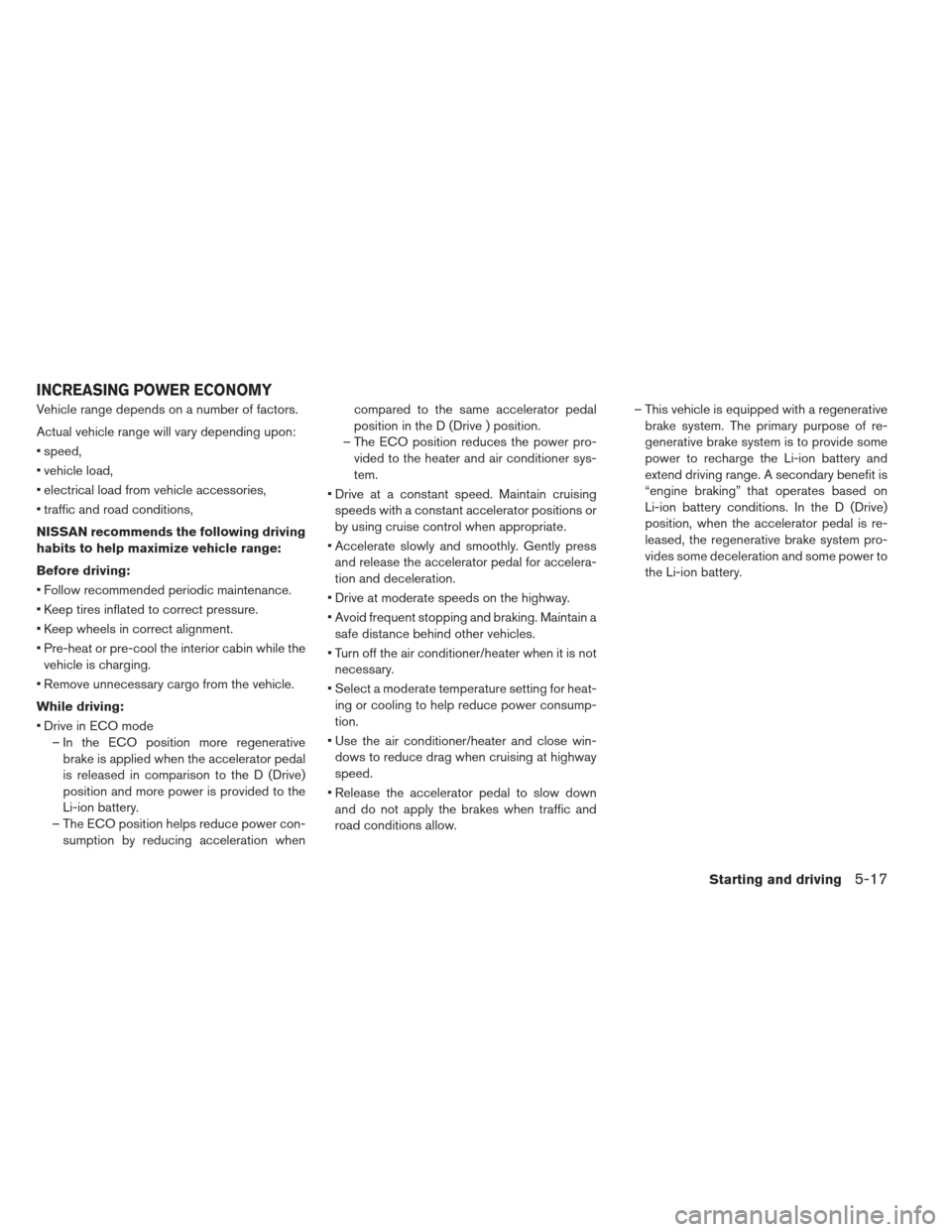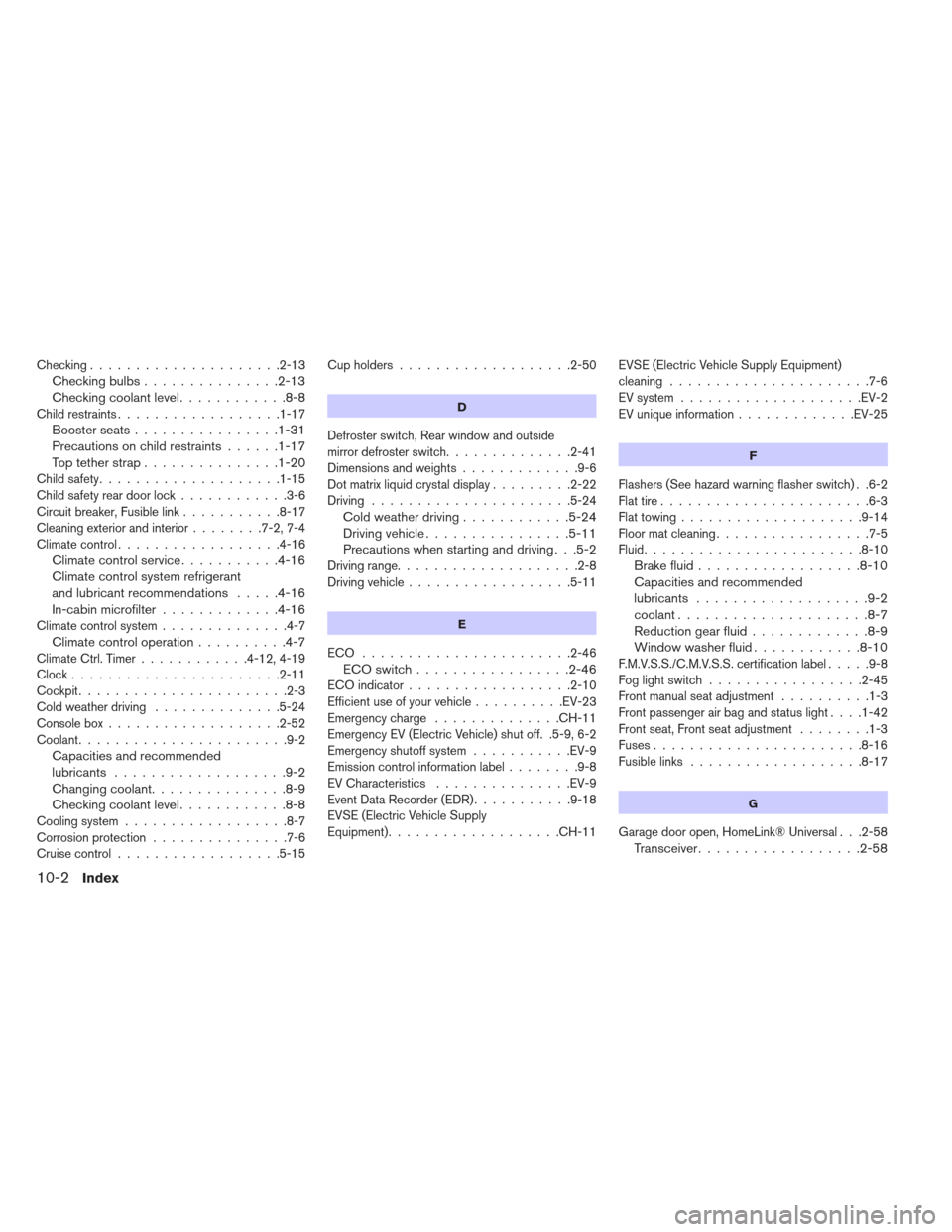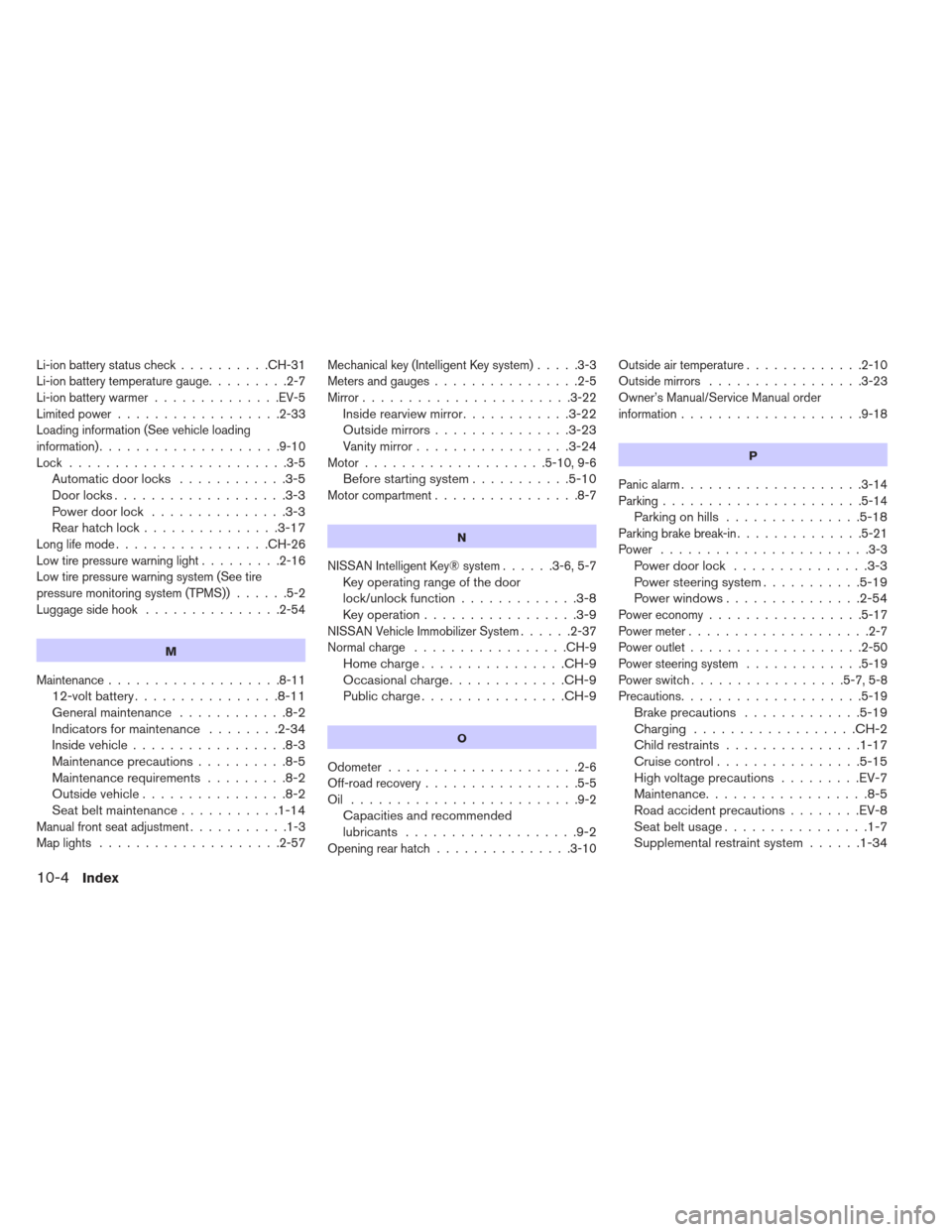2013 NISSAN LEAF cruise control
[x] Cancel search: cruise controlPage 300 of 402

Vehicle range depends on a number of factors.
Actual vehicle range will vary depending upon:
speed,
vehicle load,
electrical load from vehicle accessories,
traffic and road conditions,
NISSAN recommends the following driving
habits to help maximize vehicle range:
Before driving:
Follow recommended periodic maintenance.
Keep tires inflated to correct pressure.
Keep wheels in correct alignment.
Pre-heat or pre-cool the interior cabin while thevehicle is charging.
Remove unnecessary cargo from the vehicle.
While driving:
Drive in ECO mode – In the ECO position more regenerativebrake is applied when the accelerator pedal
is released in comparison to the D (Drive)
position and more power is provided to the
Li-ion battery.
– The ECO position helps reduce power con- sumption by reducing acceleration when compared to the same accelerator pedal
position in the D (Drive ) position.
– The ECO position reduces the power pro- vided to the heater and air conditioner sys-
tem.
Drive at a constant speed. Maintain cruising speeds with a constant accelerator positions or
by using cruise control when appropriate.
Accelerate slowly and smoothly. Gently press and release the accelerator pedal for accelera-
tion and deceleration.
Drive at moderate speeds on the highway.
Avoid frequent stopping and braking. Maintain a safe distance behind other vehicles.
Turn off the air conditioner/heater when it is not necessary.
Select a moderate temperature setting for heat- ing or cooling to help reduce power consump-
tion.
Use the air conditioner/heater and close win- dows to reduce drag when cruising at highway
speed.
Release the accelerator pedal to slow down and do not apply the brakes when traffic and
road conditions allow. – This vehicle is equipped with a regenerative
brake system. The primary purpose of re-
generative brake system is to provide some
power to recharge the Li-ion battery and
extend driving range. A secondary benefit is
“engine braking” that operates based on
Li-ion battery conditions. In the D (Drive)
position, when the accelerator pedal is re-
leased, the regenerative brake system pro-
vides some deceleration and some power to
the Li-ion battery.
INCREASING POWER ECONOMY
Starting and driving5-17
Page 309 of 402

SPECIAL WINTER EQUIPMENT
It is recommended that the following items be
carried in the vehicle during winter:
A scraper and stiff-bristled brush to remove iceand snow from the windows and wiper blades.
A shovel to dig the vehicle out of snow-drifts.
Extra window washer fluid to refill the reservoir tank.
DRIVING ON SNOW OR ICE
WARNING
Wet ice (32°F, 0°C and freezing rain) , very cold snow or ice can be slick and
very hard to drive on. The vehicle will
have much less traction or “grip” under
these conditions. Try to avoid driving
on wet ice until the road is salted or
sanded.
Whatever the conditions, drive with caution. Accelerate and slow down
with care. If accelerating too fast, the
drive wheels will lose even more trac-
tion.
Allow more stopping distance under these conditions. Braking should be
started sooner than on dry pavement. Allow greater following distances on
slippery roads.
Watch for slippery spots (glare ice) . These may appear on an otherwise
clear road in shaded areas. If a patch
of ice is seen ahead, brake before
reaching it. Try not to brake while on
the ice, and avoid any sudden steering
maneuvers.
Do not use cruise control on slippery roads.
FREEING A FROZEN CHARGE
PORT LID
When the charge port is frozen, melt the ice using
a hair dryer.
5-26Starting and driving
Page 387 of 402

Checking.....................2-13
Checking bulbs .............. .2-13
Checking coolant level ............8-8
Child restraints..................1-17
Booster seats............... .1-31
Precautions on child restraints ......1-17
Top tether strap .............. .1-20
Child safety....................1-15
Child safety rear door lock ............3-6
Circuitbreaker,Fusiblelink...........8-17
Cleaning exterior and interior ........7-2,7-4
Climatecontrol..................4-16
Climate control service ...........4-16
Climate control system refrigerant
and lubricant recommendations .....4-16
In-cabin microfilter .............4-16
Climate control system ..............4-7
Climate control operation ..........4-7
Climate Ctrl. Timer............4-12,4-19
Clock.......................2-11
Cockpit .......................2-3
Cold weather driving ..............5-24
Console box ...................2-52
Coolant.......................9-2
Capacities and recommended
lubricants .................. .9-2
Changing coolant .............. .8-9
Checking coolant level ............8-8
Cooling system..................8-7
Corrosionprotection ...............7-6
Cruise control ..................5-15 Cupholders...................2-50
D
Defroster switch, Rear window and outside
mirror defroster switch
..............2-41
Dimensionsandweights.............9-6
Dot matrix liquid crystal display .........2-22
Driving ......................5-24
Cold weather driving ............5-24
Driving vehicle ............... .5-11
Precautions when starting and driving . . .5-2
Driving range ....................2-8
Driving vehicle ..................5-11
E
ECO .......................2-46
ECO switch................ .2-46
ECOindicator..................2-10
Efficient use of your vehicle ..........EV-23
Emergency charge ..............CH-11
Emergency EV (Electric Vehicle) shut off. .5-9, 6-2
Emergency shutoff system ...........EV-9
Emission control information label ........9-8
EV Characteristics ...............EV-9
Event Data Recorder (EDR) ...........9-18
EVSE (Electric Vehicle Supply
Equipment) ...................CH-11 EVSE (Electric Vehicle Supply Equipment)
cleaning
......................7-6
EV system ....................EV-2
EV unique information .............EV-25
F
Flashers (See hazard warning flasher switch) . .6-2
Flat tire.......................6-3
Flattowing....................9-14
Floormatcleaning.................7-5
Fluid ........................8-10
Brake fluid ................. .8-10
Capacities and recommended
lubricants .................. .9-2
coolant .................... .8-7
Reduction gear fluid .............8-9
Window washer fluid ............8-10
F.M.V.S.S./C.M.V.S.S. certification label .....9-8
Foglightswitch .................2-45
Frontmanualseatadjustment ..........1-3
Front passenger air bag and status light ....1-42
Front seat, Front seat adjustment ........1-3
Fuses.......................8-16
Fusiblelinks ...................8-17
G
Garage door open, HomeLink® Universal . . .2-58
Transceiver ................. .2-58
10-2Index
Page 389 of 402

Li-ion battery status check..........CH-31
Li-ion battery temperature gauge .........2-7
Li-ion battery warmer ..............EV-5
Limited power ..................2-33
Loading information (See vehicle loading
information) ....................9-10
Lock ........................3-5
Automatic door locks ............3-5
Door locks .................. .3-3
Power door lock .............. .3-3
Rear hatch lock .............. .3-17
Long life mode.................CH-26
Low tire pressure warning light .........2-16
Low tire pressure warning system (See tire
pressure monitoring system (TPMS)) ......5-2
Luggage side hook ...............2-54
M
Maintenance...................8-11
12-volt battery ............... .8-11
General maintenance ............8-2
Indicators for maintenance ........2-34
Inside vehicle ................ .8-3
Maintenance precautions ..........8-5
Maintenance requirements .........8-2
Outside vehicle ............... .8-2
Seat belt maintenance ...........1-14
Manual front seat adjustment ...........1-3
Maplights ....................2-57 Mechanical key (Intelligent Key system)
.....3-3
Meters and gauges ................2-5
Mirror .......................3-22
Inside rearview mirror ............3-22
Outside mirrors .............. .3-23
Vanity mirror ................ .3-24
Motor....................5-10,9-6
Before starting system...........5-10
Motor compartment................8-7
N
NISSAN Intelligent Key® system ......3-6,5-7
Key operating range of the door
lock/unlock function.............3-8
Key operation ................ .3-9
NISSAN Vehicle Immobilizer System ......2-37
Normalcharge .................CH-9
Home charge ............... .CH-9
Occasional charge .............CH-9
Public charge ............... .CH-9
O
Odometer.....................2-6
Off-road recovery .................5-5
Oil .........................9-2
Capacities and recommended
lubricants .................. .9-2
Opening rear hatch...............3-10 Outside air temperature
.............2-10
Outside mirrors .................3-23
Owner’s Manual/Service Manual order
information ....................9-18
P
Panic alarm....................3-14
Parking ......................5-14
Parking on hills .............. .5-18
Parking brake break-in..............5-21
Power .......................3-3
Power door lock .............. .3-3
Power steering system ...........5-19
Power windows .............. .2-54
Powereconomy.................5-17
Powermeter....................2-7
Power outlet...................2-50
Power steering system .............5-19
Powerswitch.................5-7,5-8
Precautions ....................5-19
Brake precautions .............5-19
Charging ................. .CH-2
Child restraints .............. .1-17
Cruise control ............... .5-15
High voltage precautions .........EV-7
Maintenance ................. .8-5
Road accident precautions ........EV-8
Seat belt usage ............... .1-7
Supplemental restraint system ......1-34
10-4Index